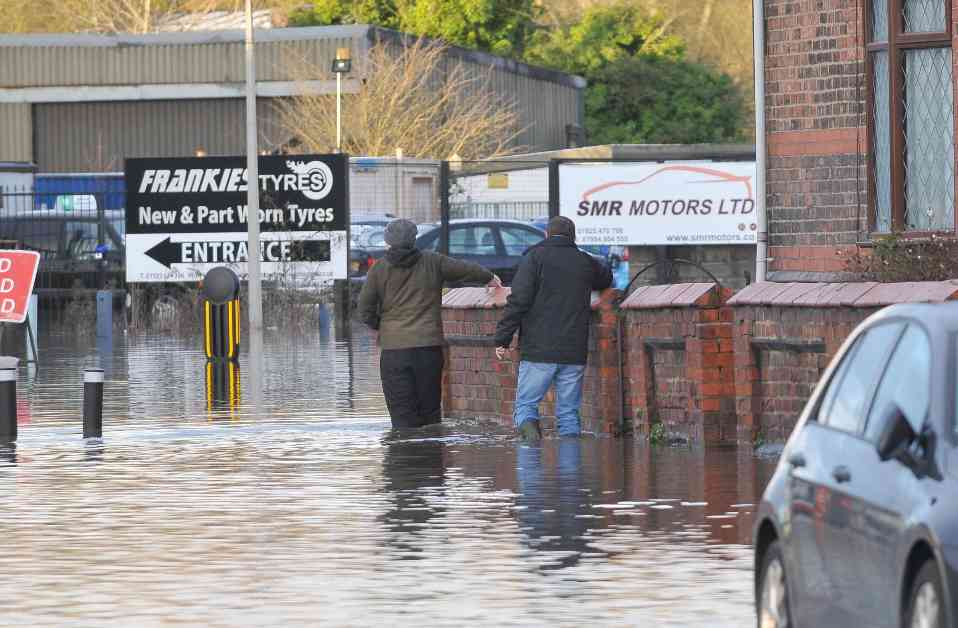Warrington Borough Council’s planning department has deemed it necessary to conduct a thorough study on the potential environmental impact of a significant flood defence project proposed for the town. The application for the scheme was submitted by the Environment Agency, prompting the council to seek a screening opinion on whether an environmental impact assessment is required.
The proposed project, known as the Sankey Brook Flood Risk Management Scheme, aims to address the risk of flooding from Sankey Brook, Dallam Brook, and Longford Brook within Warrington. The scheme covers a vast area, stretching from the north of the M62 through to the River Mersey in the south of Warrington, including Longford and Dallam Brooks, as well as areas adjacent to Sankey Canal.
According to the Environment Agency, the proposed scheme will involve the construction of new linear flood defences, such as flood walls and embankments, as well as local ground raising measures. The decision to move forward with the project comes in response to a history of flooding incidents in Warrington, with the most recent and severe event occurring in January 2021 during Storm Christoph, which led to Sankey Brook overflowing in multiple locations.
The Sankey Brook Flood Risk Management Scheme includes various components, such as 3.7km of walls, 2.4km of earth embankments, and 1,121m of ground raising. Additionally, valve gates will be installed on Dallam Brook at Longshaw Street, existing bridge parapets on Longshaw Street will be modified to serve as flood defences, temporary flood defences will be set up on Liverpool Road, the Longford Barrage pumping station will be refurbished, and measures will be implemented to reduce flooding in surface water hotspots like Sankey Bridges and Orford.
In their planning documents, the Environment Agency expressed concerns about potential significant environmental effects that may arise from the scheme, particularly related to landscape changes and visual impacts due to additional infrastructure. The agency highlighted the possibility of tree loss in various areas, as well as potential effects on protected species and habitats within wildlife sites.
After careful consideration, the council concluded that an environmental impact assessment is essential for the development of the flood defences across Warrington. The project’s scope includes designated sites located in flood zones, heritage assets, and nature conservation sites, necessitating a thorough evaluation of its potential environmental implications.
Environmental Impact Assessment Process
An environmental impact assessment (EIA) is a crucial process that evaluates the potential environmental effects of a proposed project before decisions are made. It aims to identify and mitigate any adverse impacts on the environment, taking into account factors such as landscape, biodiversity, water resources, and cultural heritage.
In the case of the Sankey Brook Flood Risk Management Scheme, an EIA is deemed necessary to assess the project’s potential impacts on the surrounding environment, including the landscape, wildlife, and habitats. The assessment will involve a detailed analysis of the proposed flood defences and their effects on the local ecosystem, as well as measures to minimize any negative consequences.
The EIA process will involve various stages, including scoping, baseline data collection, impact prediction, mitigation measures, monitoring, and reporting. It will require input from various stakeholders, including environmental experts, local communities, and regulatory authorities, to ensure a comprehensive evaluation of the project’s environmental implications.
Importance of Environmental Protection
Protecting the environment is essential for the well-being of current and future generations. Environmental degradation can have far-reaching consequences, including loss of biodiversity, depletion of natural resources, and increased vulnerability to natural disasters like flooding. By conducting an EIA for the Sankey Brook Flood Risk Management Scheme, Warrington Borough Council is taking proactive steps to safeguard the town’s environment and enhance its resilience to climate change.
The proposed flood defences aim to reduce the risk of flooding in Warrington and protect local communities and infrastructure from the adverse effects of extreme weather events. However, it is crucial to ensure that these measures are implemented in a sustainable and environmentally sensitive manner to minimize any unintended consequences on the natural environment.
Community Engagement and Consultation
In addition to the EIA process, community engagement and consultation are vital aspects of the Sankey Brook Flood Risk Management Scheme. Local residents, businesses, and stakeholders should have the opportunity to provide input and feedback on the proposed project, as their perspectives and concerns are essential in shaping the development of the flood defences.
Engaging with the community can help build trust and transparency in the decision-making process, ensuring that the project reflects the needs and priorities of the people it aims to protect. By involving the community in the planning and implementation of the flood defences, Warrington Borough Council can foster a sense of ownership and collaboration that enhances the project’s overall effectiveness and sustainability.
In conclusion, the Sankey Brook Flood Risk Management Scheme represents a significant investment in protecting Warrington from the impacts of flooding. By conducting an environmental impact assessment, engaging with the community, and prioritizing environmental protection, the council is taking proactive steps to enhance the town’s resilience to climate change and safeguard its natural environment for future generations.




















